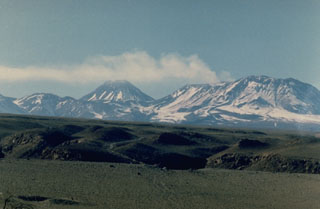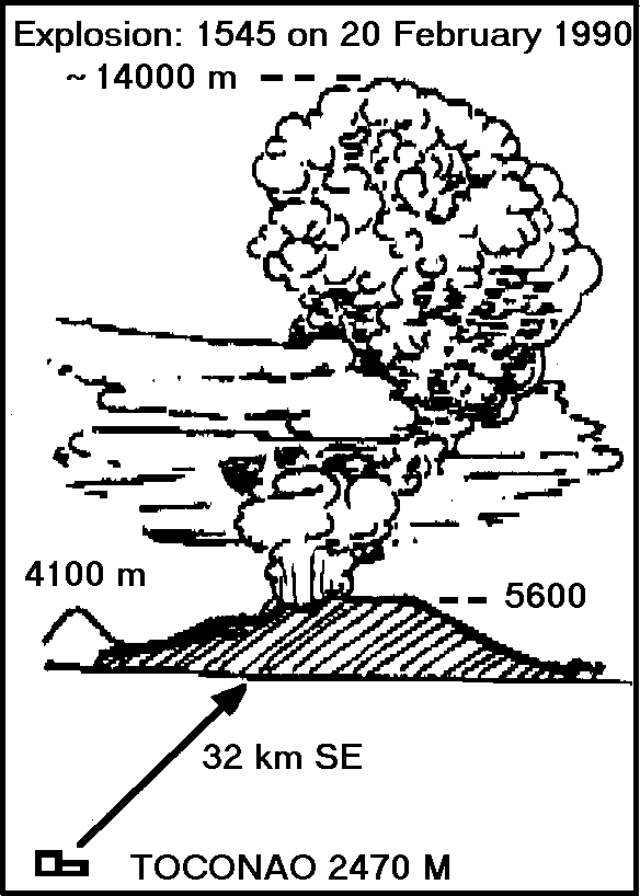Report on Lascar (Chile) — February 1990
Bulletin of the Global Volcanism Network, vol. 15, no. 2 (February 1990)
Managing Editor: Lindsay McClelland.
Lascar (Chile) Explosion produces large tephra cloud and ejects ballistic blocks to 5 km; lava dome activity increases
Please cite this report as:
Global Volcanism Program, 1990. Report on Lascar (Chile) (McClelland, L., ed.). Bulletin of the Global Volcanism Network, 15:2. Smithsonian Institution. https://doi.org/10.5479/si.GVP.BGVN199002-355100
Lascar
Chile
23.37°S, 67.73°W; summit elev. 5592 m
All times are local (unless otherwise noted)
An explosive episode on 20 February at 1545 ejected an eruption column that contained large amounts of water vapor and some tephra. Gentle winds during the activity allowed a large plume to develop, reaching ~8 km above the crater (almost 14 km altitude; figure 4). The activity appeared to be phreatomagmatic (but see comment by González-Ferrán below), consisted of only a single pulse [but see 15:03], and lasted for ~5 minutes. Near-summit winds shifted the plume slightly southward, then high-altitude winds carried away the upper part of the plume to the south. The plume had completely dispersed 30 minutes after the eruption. No felt pre-eruption seismicity was reported. Sounds from the explosion were reported to ~150 km from the volcano. Eruption-related noises were heard 40 km SW of the volcano (by Stephen Foot) at 1547, and windows rattled at Toconao, 32 km NW. As of 16 March, no new major eruptions have been reported, and the volcano has continued to show its normal fumarolic activity.
With the support of the Chilean Air force, Oscar González-Ferrán carried out an aerial and ground investigation between 22 and 26 February. During aerial reconnaissance on 24 February between about 0800 and 0900, an active lava dome remained in the crater. Numerous incandescent radial and concentric fractures were visible on the dome, and strong gas emission was occurring. Fieldwork on 24 and 25 February between Tumbre (N of the volcano) and Laguna de la Legia to ~5,400 m altitude on the SE flank, revealed that numerous blocks from the dacitic lava dome had been ballistically ejected to distances of as much as 5 km (figure 5). The blocks ranged from 0.5 to 1.5 m3 and formed impact craters as much as 4 m across and 1 m deep. Sotero Armella, president of the Residents' Council of the town of Talabre (11 km NW of Lascar) noted that large ballistic tephra had not been ejected this far during the 1986 and 1988 activity.
Stephen Foot conducted additional fieldwork on 11 March. On the SSE flank, he found bombs within 4 km of the crater and lapilli at greater distances. Bombs had formed craters up to 4 m wide and 1.5 m deep. Three types of bombs were sampled: dark, dense, glassy, crystal-rich, possibly dacitic material; light gray pumiceous fragments; and less abundant white, dense, crystal-rich, mafic-poor, weakly aligned tephra that may not have been juvenile. The tephra were found both intact and shattered, showing breadcrust texture and cooling fractures. No evidence of new tephra was found on the W flank, 16 km from the crater.
González-Ferrán noted that analyses of vertical airphotos, video, and field reconnaissance suggest that: 1) the rate of extrusion of the dacitic lava dome has increased; 2) the weakest sector of the volcano is its NW wall, so the hazard from a possible lateral explosion is greatest in that direction; and 3) the 20 February explosion was primarily from magmatic degassing rather than phreatomagmatic activity, given the long drought that has affected the area. He added that the village of Talabre (population 76, 40 of whom are children), relocated at its present site on 25 April 1985, is in the direction of highest estimated risk.
Geological Summary. Láscar is the most active volcano of the northern Chilean Andes. The andesitic-to-dacitic stratovolcano contains six overlapping summit craters. Prominent lava flows descend its NW flanks. An older, higher stratovolcano 5 km E, Volcán Aguas Calientes, displays a well-developed summit crater and a probable Holocene lava flow near its summit (de Silva and Francis, 1991). Láscar consists of two major edifices; activity began at the eastern volcano and then shifted to the western cone. The largest eruption took place about 26,500 years ago, and following the eruption of the Tumbres scoria flow about 9000 years ago, activity shifted back to the eastern edifice, where three overlapping craters were formed. Frequent small-to-moderate explosive eruptions have been recorded since the mid-19th century, along with periodic larger eruptions that produced ashfall hundreds of kilometers away. The largest historical eruption took place in 1993, producing pyroclastic flows to 8.5 km NW of the summit and ashfall in Buenos Aires.
Information Contacts: O. González-Ferrán, Univ de Chile; S. Foot, MINSAL Ltd., Santiago; J. Gerneck, Chile Hunt Oil, Toconao; M. Gardeweg, SERNAGEOMIN, Santiago.



